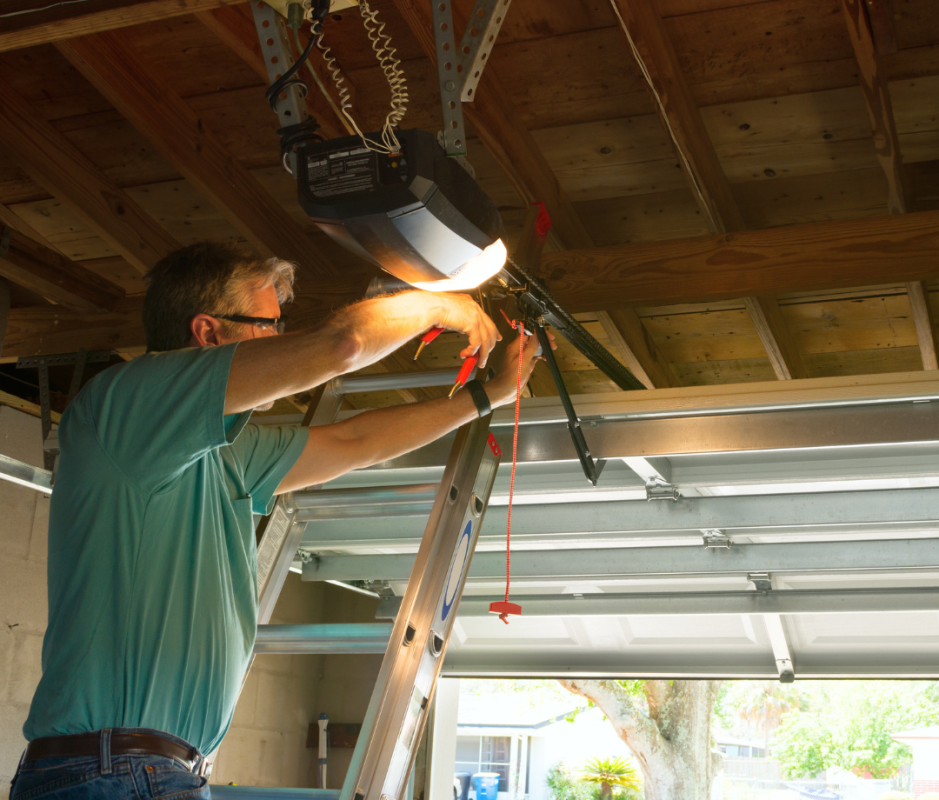Men’s Journal aims to feature only the best products and services. If you buy something via one of our links, we may earn a commission. Prices are accurate and items in stock at time of publishing.
If it’s been a minute since you gave your garage any TLC (no shame!), it’s probably high time that you performed some garage door spring maintenance. And the start of fall is the perfect time for some seasonal upkeep, particularly when it comes to your garage door. Proper garage door spring maintenance helps ensure your door runs smoothly (and silently) year-round. And as the weather gets colder and snow enters the forecast, you’re more likely to really need your garage door to work correctly.
A well-maintained garage door can also help you avoid heat loss in the winter and fend off heat gain during the summer months, and the springs play an essential role in balancing the weight of the door when it’s being opened and closed. To put it simply, without functioning springs, you wouldn’t be able to open your door. That’s why it’s so important to keep your garage door springs well-lubricated and in good condition. How do you do that? Let us explain.
How Often Do You Need to Do Garage Door Spring Maintenance?
In most cases, garage doors should have a tune-up at least once a year to ensure all of the parts are working smoothly and there’s no visible wear and tear or damage. However, when it comes to garage door springs in particular, it’s recommended that you inspect and lubricate them twice a year to minimize stress, dust build-up, and rust for maximum functionality and longevity.
What Is the Best Lubricant for Garage Door Springs?
The best lube for garage door springs is a white lithium- or silicon-based lubricant, which will provide the proper viscosity. If you already have it handy, your might be wondering whether the standard WD-40 formula can be used on garage doors. Most experts don’t recommend using it for your springs because the formula is too thin and dries out too fast. A thick coat is necessary to help protect the springs as they coil and uncoil when the door opens and closes. Alternatively, if you’re a fan of the WD-40 brand, you can use their white lithium grease spray for your garage door springs.
Related: We Painstakingly Reviewed the Best Power Tools of 2025. These Are Our Top Picks
Other Ways to Extend the Life of Garage Door Springs
Garage doors have several moving parts that work together to ensure they open and close as intended while avoiding unnecessary friction and tension that could wear down the springs. Properly caring for all these components, in addition to your garage door springs, will help extend the lifespan of the springs. This is what you need to do.
1. Inspect your garage door hardware
Take a close look at each element of the garage door, including the tracks, hinges, rollers, and springs. Look for signs of corrosion, wear, or visible damage. If all parts are in good condition, lubricate them.
2. Service the garage door chain or belt
Motorized garage door openers use either a chain or a belt drive to help lift the door. Regardless of what type you have, it is crucial to service these parts. Over time, they can loosen up and need to be adjusted. Plus, lubrication might be needed along the chain or belt drive.

Getty Images
3. Change batteries and bulbs as needed
Typically, batteries and bulbs don’t need to be swapped out that often. However, a good rule of thumb is to change them once or every other year, depending on the climate where you live and how often you use your remote or wall garage door opener.
4. Maintain friction points
There are several components that create friction in your garage door, including the hinge pins, roller bearings, springs, and belt or chain drive. If you are opening and closing your garage door on a daily basis, eventually all of these moving parts will start to create friction, which translates to those squeaking and rattling noises you may hear when your door is in use. The solution? Apply lubrication. Use a white lithium- or silicon-based lube to keep all of these parts well lubricated and to enhance their performance and durability.
5. Clean the garage door
A clean garage door not only looks good but also helps you identify potential issues that need to be fixed, such as rips in your weather shield strip. This is important to keep an eye on because it’s designed to prevent cold and hot air from entering your home and also keep out rodents or insects looking for a warm place to live. If your door is dirty, small cracks might go unnoticed.
Related: We Tested Dozens of Home Workshop Tools. These Top Picks Are Worth Your Money
Types of Garage Door Springs
The most frequently used types of garage door springs are torsion springs and extension springs. They serve the same function: balancing the weight of the door and assisting in opening and closing it.
Torsion springs are made of heavy-duty steel material and are stronger than extension springs, making them ideal for large and heavy garage doors. They are the top choice for new garage doors and are located across the top of the door. Preventive maintenance is required at least twice a year.

Getty Images
On the other hand, extension springs are located on each side of the garage door, in line with the track support system. And like their counterpart, they also need upkeep every six months.
Regardless of the type of springs you have, it is extremely important to replace them if they show signs of damage, rusting, or if they have lost tension.
